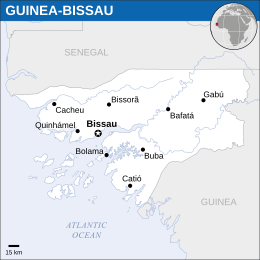Republic of Guinea-Bissau: Difference between revisions
m (Added category.) Tag: Visual edit |
No edit summary Tag: Visual edit |
||
| Line 1: | Line 1: | ||
{{Infobox country|name=Republic of Guinea-Bissau|native_name=República da Guiné-Bissau|capital=[[Bissau]]|largest_city=[[Bissau]]|official_languages=Portuguese|area_km2=36,125|population_estimate=1,726,000|population_estimate_year=2021}} | {{Infobox country|name=Republic of Guinea-Bissau|native_name=República da Guiné-Bissau|image_flag=Flag of Guinea-Bissau.svg|image_coat=Emblem of Guinea-Bissau.svg|capital=[[Bissau]]|largest_city=[[Bissau]]|mode_of_production=[[Capitalism]]|image_map=Guinea-Bissau map.svg|map_width=260|official_languages=Portuguese|area_km2=36,125|population_estimate=1,726,000|population_estimate_year=2021}} | ||
'''Guinea-Bissau''', officially the '''Republic of Guinea-Bissau''', is a country in [[West Africa]]. | '''Guinea-Bissau''', officially the '''Republic of Guinea-Bissau''', is a country in [[West Africa]]. | ||
== History == | == History == | ||
=== Pre-colonial era === | |||
Before the colonial invasion, the Fula were the dominant [[Feudalism|feudal]] group and the Balantes lived in a [[Stateless society|stateless]] [[Primitive communism|communal society]]. The feudal groups were predominantly [[Islam|Muslim]] with the exception of the Manjaks. Chiefs served as the equivalent of feudal lords and exploited the [[peasantry]]. Artisans and traders (dyulas) existed between these two classes.<ref name=":0">{{Citation|author=[[Amilcar Cabral]]|year=1964|title=Brief Analysis of the Social Structure in Guinea|mia=https://www.marxists.org/subject/africa/cabral/1964/bassg.htm}}</ref> | |||
=== Colonialism === | === Colonialism === | ||
Under [[Portugal|Portuguese]] colonial rule, Guinea-Bissau had a small [[proletariat]] and a large [[peasantry]].<ref name=":1" /> Fula chiefs collaborated with the colonizers and became [[Comprador|compradors]].<ref name=":0" /> | |||
In 1956, [[Amilcar Cabral]] founded the [[African Party for the Independence of Guinea and Cape Verde|African Party for Independence]], which advocated for independence of Guinea-Bissau and [[Republic of Cabo Verde|Cape Verde]] from Portugal. [[International and State Defense Police|PIDE]], the Portuguese secret police, attempted to crush the independence movement and killed Cabral in 1973. Later that year, Guinea-Bissau and Cape Verde declared independence. The [[Armed Forces Movement]] led a rebellion of Portuguese troops against [[fascism]] and disobeyed orders to help the independence movement.<ref>{{News citation|author=Danny Shaw|newspaper=[[Liberation School]]|title=Amilcar Cabral and the national liberation movement of Guinea Bissau and Cape Verde|date=2011-01-26|url=https://www.liberationschool.org/amilcar-cabral-and-the-national-liberation-movement-of-guinea-bissau-and-cape-verde/|archive-url=https://web.archive.org/web/20210711193152/https://www.liberationschool.org/amilcar-cabral-and-the-national-liberation-movement-of-guinea-bissau-and-cape-verde/|archive-date=2021-07-11|retrieved=2022-07-23}}</ref> | In 1956, [[Amilcar Cabral]] founded the [[African Party for the Independence of Guinea and Cape Verde|African Party for Independence]], which advocated for independence of Guinea-Bissau and [[Republic of Cabo Verde|Cape Verde]] from Portugal. [[International and State Defense Police|PIDE]], the Portuguese secret police, attempted to crush the independence movement and killed Cabral in 1973. Later that year, Guinea-Bissau and Cape Verde declared independence. The [[Armed Forces Movement]] led a rebellion of Portuguese troops against [[fascism]] and disobeyed orders to help the independence movement.<ref name=":1">{{News citation|author=Danny Shaw|newspaper=[[Liberation School]]|title=Amilcar Cabral and the national liberation movement of Guinea Bissau and Cape Verde|date=2011-01-26|url=https://www.liberationschool.org/amilcar-cabral-and-the-national-liberation-movement-of-guinea-bissau-and-cape-verde/|archive-url=https://web.archive.org/web/20210711193152/https://www.liberationschool.org/amilcar-cabral-and-the-national-liberation-movement-of-guinea-bissau-and-cape-verde/|archive-date=2021-07-11|retrieved=2022-07-23}}</ref> | ||
== References == | == References == | ||
Revision as of 22:06, 16 February 2023
| Republic of Guinea-Bissau República da Guiné-Bissau | |
|---|---|
 | |
| Capital and largest city | Bissau |
| Official languages | Portuguese |
| Dominant mode of production | Capitalism |
| Area | |
• Total | 36,125 km² |
| Population | |
• 2021 estimate | 1,726,000 |
Guinea-Bissau, officially the Republic of Guinea-Bissau, is a country in West Africa.
History
Pre-colonial era
Before the colonial invasion, the Fula were the dominant feudal group and the Balantes lived in a stateless communal society. The feudal groups were predominantly Muslim with the exception of the Manjaks. Chiefs served as the equivalent of feudal lords and exploited the peasantry. Artisans and traders (dyulas) existed between these two classes.[1]
Colonialism
Under Portuguese colonial rule, Guinea-Bissau had a small proletariat and a large peasantry.[2] Fula chiefs collaborated with the colonizers and became compradors.[1]
In 1956, Amilcar Cabral founded the African Party for Independence, which advocated for independence of Guinea-Bissau and Cape Verde from Portugal. PIDE, the Portuguese secret police, attempted to crush the independence movement and killed Cabral in 1973. Later that year, Guinea-Bissau and Cape Verde declared independence. The Armed Forces Movement led a rebellion of Portuguese troops against fascism and disobeyed orders to help the independence movement.[2]
References
- ↑ 1.0 1.1 Amilcar Cabral (1964). Brief Analysis of the Social Structure in Guinea. [MIA]
- ↑ 2.0 2.1 Danny Shaw (2011-01-26). "Amilcar Cabral and the national liberation movement of Guinea Bissau and Cape Verde" Liberation School. Archived from the original on 2021-07-11. Retrieved 2022-07-23.

